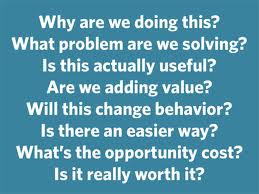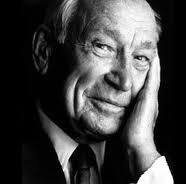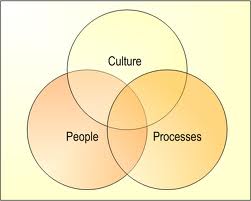 Welcome to O.D. Fridays at DonorDreams blog. Every Friday for the foreseeable future we will be looking more closely at a recent post from John Greco’s blog called “johnponders ~ about life at work, mostly” and applying his organizational development messages to the non-profit community.
Welcome to O.D. Fridays at DonorDreams blog. Every Friday for the foreseeable future we will be looking more closely at a recent post from John Greco’s blog called “johnponders ~ about life at work, mostly” and applying his organizational development messages to the non-profit community.
Today, we’re focusing on a post that John titled “Forward!“. In that post, he talks about monks and revolutionaries and how crying out the battle command “FORWARD” means different things to those two groups of people. You really need to click over and read John’s post because it hits the nail on the head.
After reading “Forward!” two thoughts came into my head as it relates to non-profit organizations.
- The existence of the “executive committee” is dangerous, especially if you aren’t careful about who sits on that committee.
- There are so many different decision-making paradigms that non-profit boards can use to make tough decisions, but few ever pay attention to these options.
Executive Committee
 I believe that BoardSource is the non-profit sector’s leading authority on all things board governance. In an article titled “Should nonprofit boards have execuitve committees” they say:
I believe that BoardSource is the non-profit sector’s leading authority on all things board governance. In an article titled “Should nonprofit boards have execuitve committees” they say:
“An executive committee can be an efficient tool, but not every board needs one. An executive committee should never replace the full board. “
I go a little farther than my diplomatic friends at BoardSource. While there are certainly times an executive committee makes sense (go read the BoardSource article), I think those circumstances are far and in between, and most non-profit organizations should banish their executive committee to their organizational waste bin!
As John talks about in his post titled “Forward!,” your board of directors has people with different values and agendas. If you boil it down in the same way John did, then you have people who thirst for change and you have people who fight against change. This dynamic is at play all around us (turn on CNN and spend some time following the Presidential election coverage), and it is at play in your boardroom.
If you have an executive committee full of “revolutionaries” (as John puts it), then you have set-up a sitution where a small group of board members can cry “FORWARD” and drag the rest of the board of directors with them (including over a cliff). Chaos reigns!
 OK, my example might be a worst-case scenario . . . but I’ve seen it happen with my own two eyes.
OK, my example might be a worst-case scenario . . . but I’ve seen it happen with my own two eyes.
Perhaps, a more common situation is where board members who aren’t on the executive committee disengage and stop attending board meetings. Yes, this can be the executive committee’s fault because the disengaged board member doesn’t see the urgency in attending board meetings or ensuring that quorum is attained. Why? Because the executive committee can always meet and take care of any pressing issue.
Ugh! If you must have an executive committee, I encourage you to use it sparingly and only in emergency situation. Most importantly, pay attention to who you put on the executive committee and make sure there is a balance between “monks” and “revolutionaries”.
Decisions-Decisions-Decisions
If you’ve heard it once in the boardroom, then you’ve heard it a million times:
“All those in favor, say aye. Those opposed say no.”
Ahhh, yes . . . .Roberts Rules of Order, bylaws, majority rule . . . BUT it doesn’t have to be that way. There are many different decision-making paradigms that exist and some are better in certain circumstances.
 If you have been reading recent posts at DonorDreams blog, then you know that I am on a Tony Stoltzfus kick as I re-read his book “Coaching Questions: A Coach’s Guide to Powerful Asking Skills“. Tony suggests there are 13 different decision-making strategies and he offers a variety of questions to help frame issues when using each of those paradigms. The following are just a few that you might find interesting for your board when making certain decisions:
If you have been reading recent posts at DonorDreams blog, then you know that I am on a Tony Stoltzfus kick as I re-read his book “Coaching Questions: A Coach’s Guide to Powerful Asking Skills“. Tony suggests there are 13 different decision-making strategies and he offers a variety of questions to help frame issues when using each of those paradigms. The following are just a few that you might find interesting for your board when making certain decisions:
- Cost: What would it cost in terms of time and resources to do this? What would it cost if you don’t do this? What’s the cost if you don’t decide or let circumstances overtake you?
- Alignment: How well does this decision align with your passions, your values, and your calling?
- Relational: How will this course of action affect the people around you? Who will benefit, who will be hurt?
There are 10 other decision-making strategies that can be used to frame boardroom decisions, but I won’t steal Tony’s thunder. You really need to go purchase his book!
If John is right, then you have monks and revolutionaries in your boardroom. Some decisions will be tough to make. Sure, you can tilt the scales by making sure there are enough of one kind of decision-maker voting in the manner that you want and need . . . OR . . . you can be strategic and thoughtful with how you frame issues and engage board members in approaching certain decisions.
There is nothing that says you have to always use a majorty rule voting paradigm. After all, I bet that there are certain things in your organizational bylaws that require a “super majority” vote. So, why not employ a consensus building model in certain circumstances? It isn’t right in all circumstances, but it is sometimes.
Does your organization still operate with an executive committee? If so, when do you activate that group and what decisions do they typically make? Does your board use different decision-making paradigms in certain circumstances? If so, please share the specifics and how that has worked for you. You can share all of your thoughts using the comment box below.
Here’s to your health!
Erik Anderson
Founder & President, The Healthy Non-Profit LLC
www.thehealthynonprofit.com
erik@thehealthynonprofit.com
http://twitter.com/#!/eanderson847
http://www.facebook.com/eanderson847
http://www.linkedin.com/in/erikanderson847
























